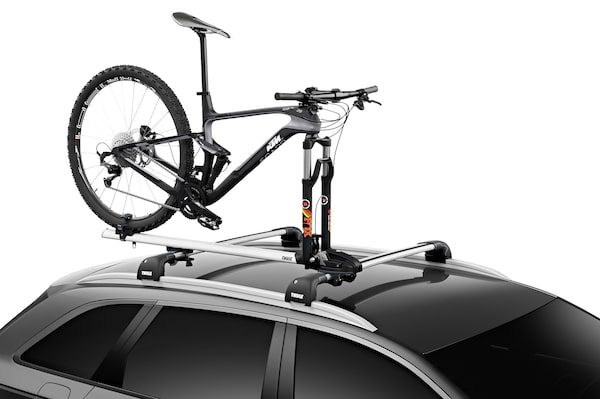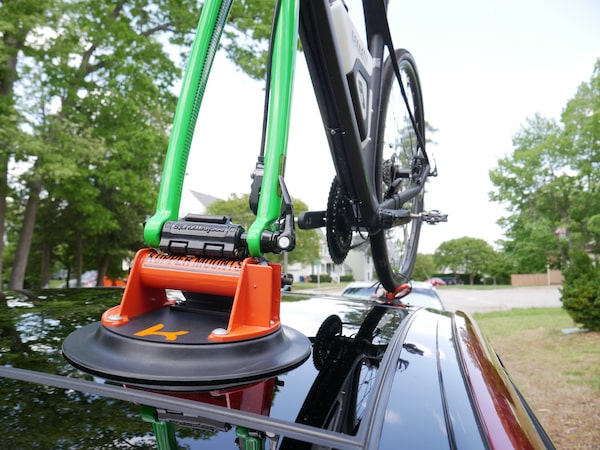Tray style bike racks are very popular because they can host any size of frame or width of crossbar without touching the frame.Joanne Elves/The Globe and Mail
Open roads, back roads, trails or rails-to-trails. It’s time to get out the two-wheelers. If your adventure doesn’t push off at the curb in front of your house, transporting the bikes to the trailhead can be a problem. A bike rack mounted on your vehicle is the answer.
But what type of rack do you need? The options are overwhelming. You need to consider your vehicle and its capabilities, the style of rack and how many bikes you plan to carry. Two other important factors are price and the need for the rack. Is it just for the kids or are you a weekend trail crusher?
The styles fall into four categories. Or, actually, if all things go right, by the end of summer you’ll have another option.
Once you have decided all the factors, head for the brick-and-mortar stores and talk to the folks selling the bikes and racks. Look for reviews online and see what other “real” people add for comments.
Trunk or hatch mounts
Most hitch-mount racks have a pin that can release to let you access the trunk.Joanne Elves
If you don’t have a hitch receiver on your vehicle, consider a removable and lightweight trunk-mount bike rack. Usually they are easy to install, but care must be taken to make sure the nylon straps are tight and don’t flap in the breeze.
Trunk-mount pros and cons:
Pros: Lightweight, easy to transfer to other automobiles and easy to store.
Cons: No security to discourage thieves. Most are designed for standard frames so full suspension mountain bikes or bikes with irregular tubing may not fit.
Roof racks

Roof bike rack Thule Thule ThruRide Fork-mount bike rack designed to fit thru-axles without extra adapters.Handout
If your vehicle has crossbars designed to accept racks, this is an excellent option for bike racks that can be left on indefinitely. Many roof racks are designed to hold the axle on the front fork so you’ll need to store the wheels in the vehicle. With or without the front wheel on, the roof-rack system usually has trays for the wheels and a clamping device to secure the back wheel. If the front wheel stays on, it is secured with a Velcro strap.
Roof-rack pros and cons:
Pros: Put the rack on the roof and forget about it. Once you’ve mastered the wheel brace, you’ll have the bikes loaded and unloaded swiftly.
Cons: If you are vertically challenged or lightweight, raising the bike over your head might be an issue especially if your auto is an SUV. Speaking of SUVs, with the bikes on the top, don’t go through the drive-thru at fast-food joints. Low signage, parking garages and even forgetting that the bike is on the roof while entering your garage will make a mess of your bike. Transporting more than two bikes will be a challenge.
Hitch-mounts
There are many options within the hitch-mount carrier world, but the primary option to consider is to get either a tray-style mount or an arm support. Consider the mount option of adding carrying capacity to four bikes.
Tray styles are very popular because they can host any size of frame or width of crossbar without touching the frame. People with expensive carbon frames, fat-tire bikes and e-bikes appreciate that. The wheels rest in a tray and are secured with rubber-coated clamps on either the front wheel or on the frame. Velcro straps looped through the tire around the base add security.
Arm style is fine if you are carrying bikes with standard tubing and you don’t mind the bikes swaying as you bump along the back roads. Watch for padding and antisway mechanisms to avoid damaging the bike. Some arm-style hitches can release to swing away from the back of the vehicle making access to the truck a breeze.
Hitch-mount pros and cons:
Pros: Once the hitch is mounted, loading and unloading of the bikes is easy. Locking them to the vehicle is easy, too. Having the bikes on the back does keep them out of the wind but the chains can get really dirty from the road. Most hitch-mount racks have a pin that can release to let you access the trunk.
Cons: Hitch-mounts need a hitch and receiver so you need to add that to your budget. They also need to come off the hitch when not in use and are bulky to store. The hitch-mount adds to the length of your vehicle – something you need to remember when you park.
Truck-bed mounts
Truck beds offer a bevy of options including a padding system that lets you hook the front wheels over the tailgate that is very popular with the mountain bike crowd with heavy-duty suspension systems and large frames. Laying the bikes on top of each other is like sending them into a boxing match. Your best bet is to use a mount that secures them in place while standing.
Look for racks that mimic the styles in front of schools that offer soft pinch points or clasps that cradle the wheels. Or, check out the bar systems that are simply a bar stretching from one side of the bed to the other offering clamps that either hold the front-wheel axle (with the wheel removed) or the whole wheel. Some systems need to be bolted to the frame while others can use a hydraulic pump to squeeze the brace to the frame without worrying about the bedliner impeding the hold.
Truck-mount pros and cons:
Pros: There are plenty of options to choose from that will hold one to four bikes.
Cons: You need a truck. And, you need a truck with a bed long enough to hold your bike.
Suction cups

Kupper Mounts suction cups as bike racks have not hit the market yet, but should be available by this fall.Handout
If large sheets of glass can be transported using suction cups, why can’t suction cups attached to your vehicle transport your bike? That was the question Andrew Jarrard of Raleigh, N.C., asked when he was trying to create a lightweight inexpensive bike rack for a single bike. His Kupper Mounts have not hit the market yet, but the instant success on Kickstarter shows a lot of people have faith in the system that should be available by this fall.
Two large vacuum cups are mounted on any clean surface on your vehicle each time you want to transport your bike. The roof, the hatch or even the back window of a van will do. The front tire is removed so the front forks are locked on the nine-inch cup. The back wheel is strapped onto the six-inch cup. Simple. All you need to do is periodically check the pressure gauge. Temperature changes can affect air pressure but during testing there were no problems.
Suction cup pros and cons:
Pros: Simple to use and easy to store.
Cons: Not on the market yet. Security could be an issue if you don’t use the lock system that feeds into your door jam.
Shopping for a new car? Check out the new Globe Drive Build and Price Tool to see the latest discounts, rebates and rates on new cars, trucks and SUVs. Click here to get your price.
Stay on top of all our Drive stories. We have a Drive newsletter covering car reviews, innovative new cars and the ups and downs of everyday driving. Sign up for the weekly Drive newsletter, delivered to your inbox for free. Follow us on Instagram, @globedrive.